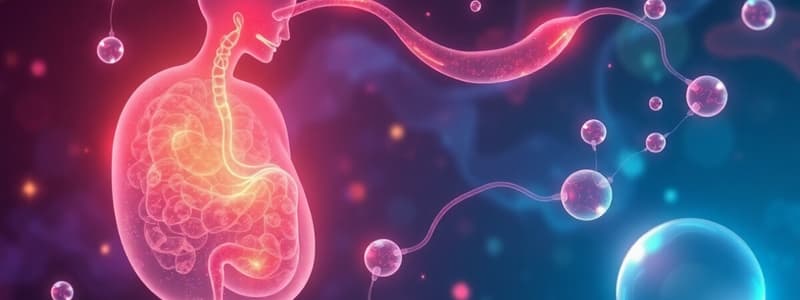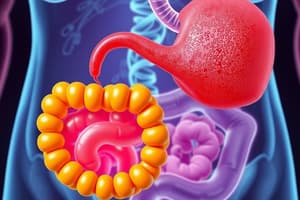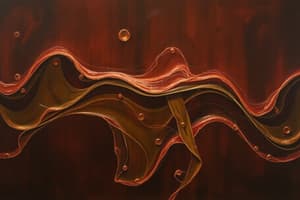Podcast
Questions and Answers
What is the primary role of bile salts in lipid digestion?
What is the primary role of bile salts in lipid digestion?
- To form micelles with dietary lipids for absorption (correct)
- To convert glycerol into glycerophosphate
- To transport lipids through the bloodstream
- To hydrolyze triglycerides into free fatty acids
Which component is primarily found in the core of lipoproteins?
Which component is primarily found in the core of lipoproteins?
- Cholesteryl ester
- Phospholipids
- Free cholesterol
- Triacylglycerol (correct)
What happens to short and medium-chain fatty acids during lipid absorption?
What happens to short and medium-chain fatty acids during lipid absorption?
- They are incorporated into micelles for absorption
- They require bile salts for their absorption
- They are converted to chylomicrons before absorption
- They enter the bloodstream directly without micelles (correct)
What forms when monoacylglycerol, fatty acids, and glycerol are reformed in enterocytes?
What forms when monoacylglycerol, fatty acids, and glycerol are reformed in enterocytes?
Which lipoprotein is primarily responsible for transporting dietary lipids from the intestines?
Which lipoprotein is primarily responsible for transporting dietary lipids from the intestines?
What is the primary component of chylomicrons?
What is the primary component of chylomicrons?
Which apolipoproteins are primarily associated with chylomicrons?
Which apolipoproteins are primarily associated with chylomicrons?
Which lipoprotein class has the highest protein content?
Which lipoprotein class has the highest protein content?
What role does lipoprotein lipase play in lipid metabolism?
What role does lipoprotein lipase play in lipid metabolism?
How are nascent VLDL formed?
How are nascent VLDL formed?
What is the cholesterol composition percentage of Low-Density Lipoprotein (LDL)?
What is the cholesterol composition percentage of Low-Density Lipoprotein (LDL)?
Which statement accurately describes the process of energy storage in adipocytes?
Which statement accurately describes the process of energy storage in adipocytes?
What happens to dietary nutrients once they enter the liver via the portal vein?
What happens to dietary nutrients once they enter the liver via the portal vein?
Which of the following correctly describes the transformation of VLDL as it loses TAG?
Which of the following correctly describes the transformation of VLDL as it loses TAG?
What is the primary function of the enzyme LCAT in HDL metabolism?
What is the primary function of the enzyme LCAT in HDL metabolism?
What initiates the endocytosis of LDL particles?
What initiates the endocytosis of LDL particles?
Which statement accurately reflects the role of SR-B1 in HDL metabolism?
Which statement accurately reflects the role of SR-B1 in HDL metabolism?
What effect does excess cholesterol have on the synthesis of cholesterol and LDL receptors?
What effect does excess cholesterol have on the synthesis of cholesterol and LDL receptors?
Flashcards
Chylomicron Composition
Chylomicron Composition
Chylomicrons are composed primarily of triacylglycerols (82%), with smaller amounts of phospholipids (7%), cholesterol (2%), and protein (9%).
VLDL Composition
VLDL Composition
Very-low-density lipoproteins (VLDL) are mainly comprised of triacylglycerols (52%), with cholesterol (18%), phospholipids (22%), and protein (8%).
Lipoprotein Lipase Function
Lipoprotein Lipase Function
Enzyme that breaks down triglycerides carried within lipoproteins into free fatty acids and monoglycerides for uptake and use in adipose and muscle tissues.
Adipocyte Lipolysis Stimulator
Adipocyte Lipolysis Stimulator
Signup and view all the flashcards
Exogenous Lipid Transport
Exogenous Lipid Transport
Signup and view all the flashcards
Endogenous Lipid Transport
Endogenous Lipid Transport
Signup and view all the flashcards
VLDL Formation Site
VLDL Formation Site
Signup and view all the flashcards
Chylomicron Remnant Fate
Chylomicron Remnant Fate
Signup and view all the flashcards
VLDL transformation
VLDL transformation
Signup and view all the flashcards
LDL receptor function
LDL receptor function
Signup and view all the flashcards
Reverse cholesterol transport
Reverse cholesterol transport
Signup and view all the flashcards
HDL maturation
HDL maturation
Signup and view all the flashcards
Cholesterol regulation
Cholesterol regulation
Signup and view all the flashcards
Lipid Digestion in Stomach
Lipid Digestion in Stomach
Signup and view all the flashcards
Lipid Digestion in Small Intestine
Lipid Digestion in Small Intestine
Signup and view all the flashcards
Lipid Absorption
Lipid Absorption
Signup and view all the flashcards
Chylomicron Formation
Chylomicron Formation
Signup and view all the flashcards
Lipoprotein Structure
Lipoprotein Structure
Signup and view all the flashcards
Study Notes
Lipid Digestion and Absorption
- Dietary lipids (TAG, cholesterol, cholesterol esters, phospholipids) enter the stomach largely intact.
- In the stomach, only TAG is acted upon by lingual and gastric lipases, which hydrolyze medium/short-chain fatty acids from the sn-3 position, yielding DAG.
- In the small intestine, TAG, along with bile salts, form micelles and are acted upon by intestinal and pancreatic enzymes.
- Short- and medium-chain fatty acids are not incorporated into micelles for absorption.
- Glycerol, MAG, lysophospholipids, cholesterol, and long-chain fatty acids are absorbed into enterocytes with transfer proteins or by diffusion.
- In enterocytes, glycerol is converted to α-glycerolphosphate. Additional α-glycerolphosphate can be formed from glucose.
- α-glycerolphosphate, fatty acids, MAG, and DAG are reformed into TAG. Lysophosphatides are re-esterified with fatty acids to form phospholipids. Cholesterol is esterified to form cholesterol esters.
- Re-formed lipids, along with apoB48, form chylomicrons, which leave the enterocyte via exocytosis into the lymphatic system, then into blood circulation. Other apolipoproteins are transferred to chylomicrons from other lipoproteins.
Lipoprotein Structure
- Lipoproteins are complexes of lipids and proteins that transport lipids in the bloodstream.
- The core of a lipoprotein is primarily composed of nonpolar lipids (triacylglycerols and cholesterol esters).
- A monolayer of amphipathic phospholipids and free cholesterol surrounds the core.
- Peripheral and integral apoproteins are also present.
Exogenous Lipid Transport
- Chylomicrons transport dietary TAG to tissues (not liver—particularly adipose and muscle).
- Apolipoproteins (apoE and C-2) are transferred to the chylomicron from HDL.
- As chylomicrons lose TAG, they become chylomicron remnants, donating apoA and apoC back to HDL.
- Chylomicron remnants attach to the liver, releasing fatty acids, cholesterol, and cholesterol esters to the liver.
Adipose Lipid Metabolism
- Glucose is converted to acetyl-CoA, which can be converted to fatty acids, stored as triacylglycerols (TAG).
- Lipoprotein lipase acts on TAG in the chylomicrons, releasing fatty acids and monoglycerides to the adipocyte. The same occurs with VLDL.
- Insulin stimulates lipogenesis, promoting glucose entry into cells and inhibiting hormonesensitive lipase that hydrolyzes stored TAG.
Liver Lipid Metabolism
- Dietary nutrients enter the liver via the portal vein.
- Glucose can be converted to glycogen or undergo glycolysis.
- Amino acids are metabolized to produce pyruvate and oxaloacetate.
- Serum free fatty acids (bound to albumin) enter the fatty acid pool (TAG).
- Chylomicron remnants are taken up by liver cells via endocytosis, releasing fatty acids, monoglycerides, and cholesterol.
- The lipids are reformed into TAG and cholesterol esters (CE) and packaged with apolipoproteins into VLDL for transport.
- VLDL delivers triglycerides to muscle and adipose tissue.
Endogenous Lipid Transport
- Nascent VLDL are formed in the liver's Golgi apparatus.
- Additional apolipoproteins (apoC and E) are added from HDL.
- Lipoprotein lipase hydrolyzes TAG in VLDL, producing smaller IDL particles.
- IDL particles are further metabolized to LDL.
- LDL particles deliver cholesterol to peripheral tissues. LDL receptors in the liver and non-hepatic tissues take up LDL.
Reverse Cholesterol Transport
- Lipid-free apoA-1 is secreted by the liver and intestines.
- ApoA-1 acquires phospholipids and cholesterol from cells via ABCA1, forming nascent HDL.
- HDL acquires more lipids from peripheral cells via ABCA1 and SR-B1.
- LCAT (lecithin:cholesterol acyltransferase) esterifies cholesterol to form cholesterol esters (CE).
- CE migrate to the HDL core, forming larger HDL particles.
- Some CE are transferred to VLDL and LDL via CETP.
- HDL can be internalized in the liver via SR-B1.
LDL Uptake
- LDL particles with apoB-100 attach to LDL receptors on cell surfaces.
- The LDL-receptor complex is internalized and fuses with lysosomes.
- LDL proteins are hydrolyzed to amino acids.
- Free cholesterol is released.
- Excess cholesterol inhibits cholesterol synthesis and LDL receptor synthesis.
- Cholesterol is esterified with ACAT and stored within the cell.
Studying That Suits You
Use AI to generate personalized quizzes and flashcards to suit your learning preferences.




